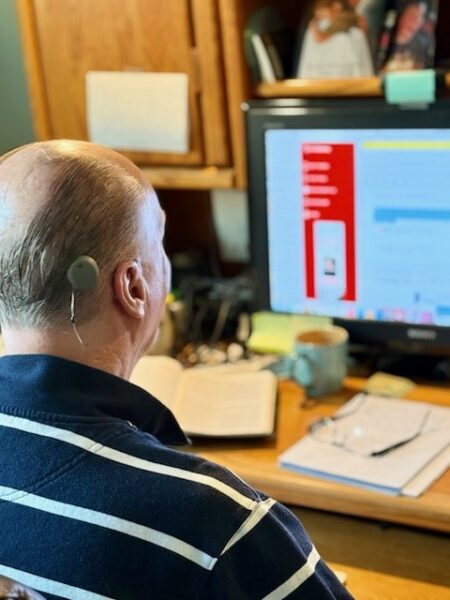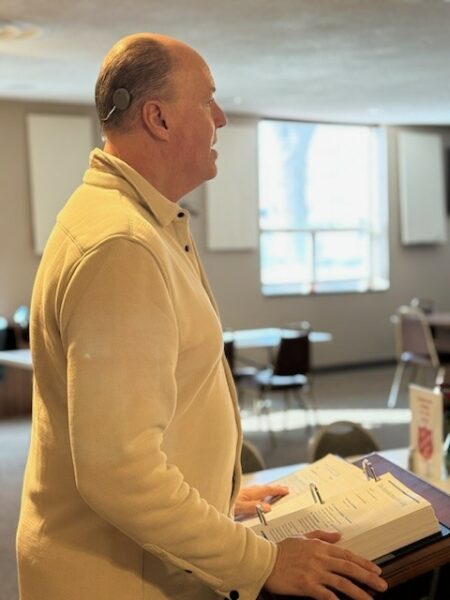Jeff has had profound hearing loss in his left ear for most of his life and relied on his right ear to hear and communicate. After sudden hearing loss on his right side, he decided to move forward with the Cochlear™ Osia® System and is hearing more clearly than he has in years.
Searching for a solution
“My journey to the Osia System unknowingly began back in July 2023. Because I’ve had profound hearing loss in my left ear for most of my life, I have relied on the normal hearing in my right ear. Beginning in early 2020, I began to notice a sudden, rapid decrease in the hearing in my right ear. After several trips to my local Ear, Nose and Throat (ENT) doctor over the course of a couple of years, I received the diagnosis of fluid on the ear, nerve damage, and other issues, and I was told the loss of hearing would probably continue and be permanent. My doctor recommended trying hearing aids.
I was fitted with a BiCROS hearing device, and it was extremely helpful. However, over time, my hearing loss continued to the point that hearing aids no longer helped. The ENT suggested my next step be a bone conduction implant. But I was still unsure of the cause of my hearing loss and was not convinced that we had done all we could. Before taking a permanent step, I requested a second opinion with an ENT at the University of Iowa hospital in Iowa City.
It was at that appointment in July 2023 that the cause of my declining hearing loss was found to be due to a massive cholesteatoma in my right ear. It had completely damaged my middle ear. I underwent surgery in October 2023 to successfully remove the cholesteatoma. In an attempt to rebuild my middle ear, I had a total ossicular replacement prosthesis (TORP) procedure in March 2024. Several months later, we discovered the TORP was not effective in restoring any of my natural hearing. So, having exhausted all options, the ENT recommended a bone conduction hearing implant.
Discovering the Osia System, and rediscovering sound
From September 2023 to November 2024, I wore a temporary Cochlear Baha® 6 Max Sound Processor with the Baha SoundArc™ because I was not able to have anything in my right ear canal. It was during this time of learning more about the Baha System and bone conduction hearing devices in general that I discovered the option of the Osia System. The more I read, the more excited I became about the possibility of the Osia System.
One of the down sides of wearing the Baha Sound Processor with the Baha SoundArc was that I was only able to wear the sound processor for short periods of time before my head and ears would become very sore. While I was grateful for what the Baha SoundArc was able to provide for me in the short term, I knew it would not be a long-term solution.
I loved that the Osia Implant was entirely under the skin, leaving none of the implant visible and only requiring a processor on the outside. I read every article and watched every video regarding the Osia System I could find online, most of them twice. Everything I saw and read only reinforced my preference and like of the Osia System.
So on November 8, 2024, I had the implant surgery, and on January 15, 2025, I had the fitting for my Cochlear Osia 2 Sound Processor. Once the audiologist turned the Osia Sound Processor on, I couldn’t believe the depth and detail of sound. It exceeded my hopes and expectations. There was such a clarity and richness to sound that I had forgotten. I was able to hear sounds from a distance as if they were right next to me. It took me several weeks to adjust to all the new sounds, and it has really given me hope going forward that I will be able to once again participate in conversations in places that were once very difficult, if not impossible.
Today, I put the Osia Sound Processor on early in the morning and wear it all day, usually 14 to 15 hours, and I hardly know it is there. I am even able to wear winter hats over the sound processor without any feedback at all. It’s great for those cold Midwest winter days.
Supporting others and enjoying life
“I am a pastor of a local church, so it is very important for me to be able to hear while visiting places like hospitals, nursing homes, hospice settings, weddings, funerals, visiting people and so many other settings. When I pair the Osia Sound Processor with my phone1 or the Mini Microphone 2+, I am able to once again participate in phone conversations and hear conversations with people in crowded and noisy environments.
I also love sharing with others what the Osia System is, what it has done for me, and what it may be able to do for others like me who have hearing loss. Because I am profoundly deaf in my left ear, I am looking into the possibility of going bilateral with the Osia System.
In the future, I look forward to all the advances Cochlear will make and how it will enable us to hear better. I am so thankful for all the Osia System has given back to me. The years to come have the potential to be the best of my life, in part, because of my Osia System.”
Learn more about the discreet, light and comfortable to wear Osia 2 Sound Processor.
- The Cochlear Osia 2 and 2(I) Sound Processors are compatible with Apple devices. For compatibility information visit www.cochlear.com/compatibility


